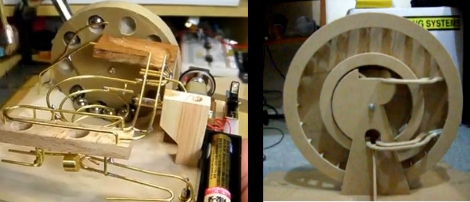
We’re going to let you decide which of these two projects is a delight, and which is amusing.
The project on the left is a desktop kinetic sculpture. We like it because of its size and simplicity. A single AA battery drives the gear head motor that provides the lift for the metal balls. There are several different routes for them to take in returning to the lift wheel, each route determined by a mechanical combination of the metal spheres. This is more of a month-long build than some of the other kinetic devices we’ve seen which could take a lifetime.
The offering on the right is a perpetual motion machine. Well, it will be once that guy gets the kinks worked out. You can see him explain how he intends this works in the video after the break. We’re not betting on perpetual motion, but if we did, our money would be on something like the Steorn Orbo replica and not on this.
[youtube=http://www.youtube.com/watch?v=40H47Z_eOKE&w=470]
[Thanks Cr8ive]















I have to admit, I am a bit embarrassed for Hackaday that they would feel so deprived of actual material as to print the words “perpetual motion machine” in earnest.
Second to that, I am in agreement with a previous commenter that it IS a bit uncomfortable to hear that man speak with such conviction; much like being buttonholed by a street preacher. Ugh…
well, the title was ‘to delight and amuse’. this entry amused me, so I’d say well done hackaday =)
Perpetual fruitcakes..
It’s not because you believe in something that it’s true.
I couldn’t even stand watching the entire video, he seems serious. On the other hand, I found the comments amusing.
put magnets in certain parts of the wheel so that whit the balls being metalic it uses also magnetic power and will be more efisient
sorry for the espelling im an ingeneer so i dont care jeje.
Magnets > God + simple math. Problem solved.
Problem?
Quick Q: In regard to a perpetual motion machine — If one were to have a compass at exactly magnetic north would it cause the compass to spin indefinitely, always producing motion?
@tapius: No, the compass would simply point down towards the molten core which is the source of the magnetic field.
Although it may turn *extremely* slowly as a result of the natural shifting in direction of Earth’s magnetic field relative to the surface of the Earth.
Make the outer wheel larger won’t work. As has been said, that would only lead to the inner wheel needing to be enlarger as well. Off the top of my head, I’d guess that it could be improved by inclining the tracks and making the balls travel up them by tapering the tracks’ rails outward so that gravity pulls the balls down and thus up the inclined tracks. I THINK this would allow more balls/weight to be constantly kept on the outer wheel than on the inner wheel. However, it may fail if the balls don’t move up the tracks fast enough. I may have to break out the old K-nex Big Ball Factory and try this out.
Even if this theory worked, though, there would still be the age-old nemesis or friction.
Last line should read “of friction.”
Cute, though anyone with a calculator should be able to explain why it won’t work.
If you want to try replicating the Steorn Orbo concept, several Steorn plans are available here:
http://steornarchive.great-site.net/
Also some links to some insider videos and such.